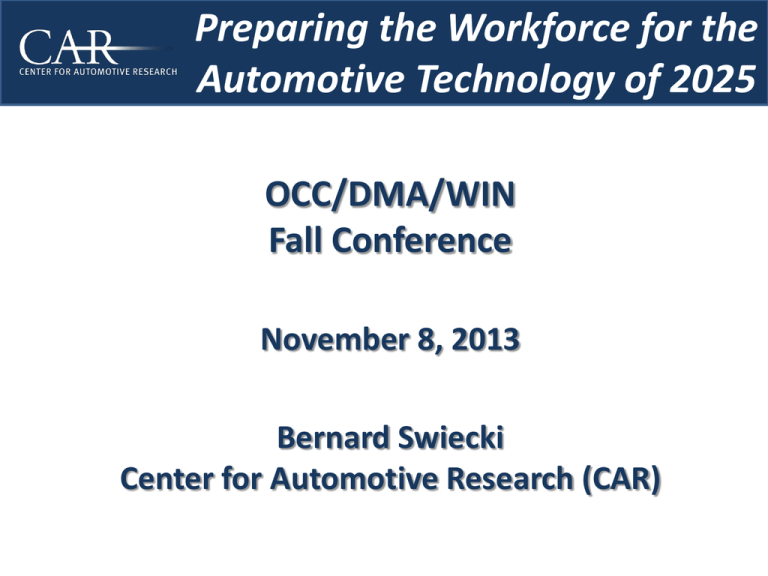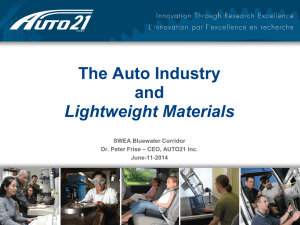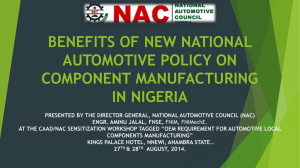DMA 2013 Swiecki Power Point
advertisement

Preparing the Workforce for the Automotive Technology of 2025 OCC/DMA/WIN Fall Conference November 8, 2013 Bernard Swiecki Center for Automotive Research (CAR) Industry Collaboration & Partnerships The Center for Automotive Research brings together stakeholders for thought leadership and industry education. CAR collaborative working groups: • • • • • • • Automotive Communities Partnership (ACP) Connected Vehicle Working Group United Tooling Coalition (UTC) Program for Automotive Labor and Education (PALE) Electric Vehicle Working Group Advanced Automotive Information Technology Solutions Consortia Coalition for Automotive Light-weighting Materials (CALM) CAR’s flagship event, August 5-8 Now in its 48th year – a “can’t miss” event More than 900 attendees Sessions on manufacturing, materials, connected vehicles, policy, sales forecasting, purchasing, strategy, & capital investment More information at www.cargroup.org Name a product … ? • • • • Which consists of nearly 30,000 parts, Can be assembled at the rate of 1 per minute, 16 hours a day, 200 days a year, Runs for several years, most of the time without a single manufacturing defect? • Is from the largest manufacturing sector in the U.S. economy. This accomplishment by the auto industry to execute mass production has become the norm. U.S. Light Vehicle Sales Percent Change YTD Through October: 2013 vs. 2012 Total 12,979,521 + 986,539 100.0% Light Trucks 6,419,453 + 676,018 49.5% Passenger Cars 6,560,068 + 310,521 50.5% Source: Automotive News; CAR Research 8.2% 11.8% 5.0% U.S. Market Share: YTD October 2013 GM Units: 2,343,861 Ford Units: 2,078,939 Toyota Units: 1,867,155 FiatChrysler Units: 1,497,086 Honda Units: 1,273,550 HyundaiKia Units: 1,057,910 Nissan Units: 1,032,134 Source: Automotive News; CAR Research 18.1% 16.0% 14.4% 11.5% 9.8% 8.2% 8.0% U.S. Light Vehicle Monthly Sales and SAAR October 2011 – October 2013 1.8 13.313.6 13.6 14.2 14.9 14.414.4 14.1 14.114.5 14.3 13.8 1.4 1.4 1.2 1.1 1.2 1.0 15.615.415.215.3 1.0 1.0 1.3 1.2 1.3 1.3 1.2 1.2 1.1 15.3 15.2 1.5 1.4 1.2 16 15.9 1.4 1.3 1.1 15.816.1 15.5 1.515.3 15.2 14 1.4 1.3 12 1.1 1.2 1.0 0.9 10 8 0.8 6 0.6 4 0.4 2 0.2 0 Oct-11 Nov-11 Dec-11 Jan-12 Feb-12 Mar-12 Apr-12 May-12 Jun-12 Jul-12 Aug-12 Sep-12 Oct-12 Nov-12 Dec-12 Jan-13 Feb-13 Mar-13 Apr-13 May-13 Jun-13 Jul-13 Aug-13 Sep-13 Oct-13 Monthly Sales (Millions) 1.6 15.1 SAAR Source: Automotive News; CAR Research Monthly SAAR SALES Big 7 Monthly U.S. Market Share 1999 – 2013 YTD (October) 35% Ford GM Chrysler Honda Hyundai-Kia Nissan Toyota 30% Percent of U.S. Market Sales 29.4% 25% 24.7% 20% 18.0% 15% 16.0% 14.4% 15.6% 11.5% 9.8% 8.2% 8.0% 10% 8.7% 5% 6.4% 4.0% 0% 1.8% Year Source: Automotive News; CAR Research Motor Vehicle & Parts Manufacturing Employment 1999 – July 2013 Michigan 400,000 50% change 316,300 681,500 64% change 153,500 53% change 600,000 148,500 400,000 81,500 105,100 200,000 50,000 0 800,000 47% change 70,200 1999 2000 2001 2002 2003 2004 2005 2006 2007 2008 2009 2010 2011 2012 July 2013 Source: BLS, U.S. DOL 0 U.S. State Level 1,000,000 200,000 100,000 U.S. 1,200,000 250,000 150,000 Ohio 1,130,900 350,000 300,000 Indiana Per Vehicle Profits*, North America 2006—2013/1stH $3,000 $3,000 $1,921 $2,000 $1,391 $1,000 $2,058 $2,275 $2,124 $2,000 $1,543 $1,094 $1,120 $995 $975 $1,000 $452 $(306) $$(1,000) $- Detroit Three $(1,054) $(1,416) Toyota and Honda $(2,000) $(1,000) $(2,000) $(3,308) $(3,229) $(3,000) $(3,000) $(4,000) $(4,000) 2006 2007 2008 2009 2010 2011 2012 *EBIT or automotive operating income per vehicle sold. Global average for Chrysler figure. Honda excludes motorcycle, finance, and power products. 1H 2013 Quarterly GDP Growth Rate 07/1Q – 13/2Q 6.0 4.9 4.0 2.0 3.9 3.1 2.7 1.3 0.3 -2.0 -4.0 1.6 -2.7 2.8 1.4 2.5 1.2 1.1 0.1 -0.4 0.0 3.7 3.2 2.8 2.8 2.0 1.5 3.9 -1.3 -2.0 -5.4 -6.0 -8.0 -8.3 -10.0 1Q 3Q 1Q 3Q 1Q 3Q 1Q 3Q 1Q 3Q 1Q 3Q 1Q 2007 2007 2008 2008 2009 2009 2010 2010 2011 2011 2012 2012 2013 Source: Bureau of Economic Analysis; Federal Open Market Committee Auto Sales and Economic Growth are Disconnected U.S. GDP Growth Rate and Vehicle Sales Growth Rate 1952 – Q2 2013 GDP Growth 12.0 40 10.0 30 GDP Growth Rate 8.0 20 6.0 10 4.0 0 2.0 -10 0.0 -2.0 -20 -4.0 -30 52 57 62 67 Source: Bureau of Economic Analysis 72 77 82 87 92 97 02 07 12 Vehicle Sales Growth Rate Sales Growth They are Getting Old . . . U.S. Light Vehicle Age and Scrappage Rate Average Age 8.6 8.8 8.8 6.78 8.9 6.74 5.88 5.76 8.9 9.0 9.1 9.4 Scrappage Rate (%) 9.5 9.7 9.8 10.0 6.40 6.19 5.50 4.76 5.03 5.24 4.35 10.3 5.66 10.6 5.21 10.9 11.2 11.4 4.90 4.12 1997 1998 1999 2000 2001 2002 2003 2004 2005 2006 2007 2008 2009 2010 2011 2012 2013 Source: R.L. Polk Unemployment Rate January 2008 – July 2013 Michigan 15% Indiana Ohio U.S. 14.2% 14% 13% 12% 10.8% 11% 10.6% 10% 10.0% 9% 8% 7% 10.6% 8.8% 8.7% 8.4% 7.1% 6% 5.7% 5% 5.0% 4% 4.7% Source: Bureau of Labor Statistics 7.4% 7.2% U.S. Light Vehicle CAR Sales Forecast: 2007-2016 18 16 8.3% 16.1 13.3% 13.2 14 12 16.0 16.2 16.2 2013 2014 2015 2016 14.5 10.4% 11.6% 15.7 12.8 11.6 10.4 10 8 6 4 2 0 2007 2008 Source: CAR Research, Oct. 2012 2009 2010 2011 2012 U.S. Vehicle Production & Automotive Employment Forecasts 2013-2016 Employment not growing much: • Third party workers • More imported parts and components • More overtime and temporary workers 14,000,000 • High productivity rate 800,000 12,000,000 700,000 8,000,000 6,000,000 600,000 4,000,000 2,000,000 Vehicle Production Automotive Employment 2011 2012 2013 2014 2015 2016 8,669,700 10,375,257 11,000,000 11,300,000 11,500,000 11,400,000 603,400 647,500 670,000 688,000 700,000 695,000 Source: Automotive News; CAR Research; BLS, July 2013 500,000 Employment Production 10,000,000 Manufacturing Efficiency Taiichi Ohno: Toyota Production System Global Supply Chains Flexible Manufacturing & Industrial Robotics Global Platforms Digital Engineering & Manufacturing EPA Estimate gCO2/Mile Standard 310 290 270 250 230 210 190 170 150 Grams CO2/mile Equivalent Fuel Economy Standard (MPG) Fuel Economy Regulation Projections 60 55 CAFE mpg 54.5 50 45 40 35 30 25 20 Source: EPA and NHTSA Fuel Economy & Safety The most likely dramatic changes for the automotive market through 2025 could well be a result of mandates by the federal government to improve the fuel economy performance and vehicle safety North American Automotive Manufacturing and R&D Clusters, 2011 Auto: Over 1M U.S. jobs (incl. spinoff) Over $12B/year private R&D in Michigan © Center for Automotive Research, April 2013 Automotive Innovation New technologies … what’s coming next ? • Powertrain • Materials (Lightweighting and Crashworthiness) • Electronics • Safety • Road use • Convenience • Many supportive ones Percent Fuel Consumption Reduction Assessment of Technologies for Improving Light-Duty Vehicle Fuel Economy – Over 40 Technologies 35.0% 30.0% High Impact - Strategic 25.0% 20.0% 15.0% Incremental – Low Risk 10.0% 5.0% 0.0% * Preceding Technology Required Source: NAS 2011 22 Average Material Content of North American Light Vehicles 50.0% 45.0% 40.0% 35.0% 30.0% 25.0% Image: Porsche 20.0% 15.0% 10.0% 5.0% 0.0% 1995 Data source: Wards 2000 2005 2010 Average Material Content of North American Light Vehicles 50.0% 45.0% 40.0% 35.0% 30.0% 25.0% Image: Porsche 20.0% 15.0% 10.0% 5.0% 0.0% 1995 Data source: Wards 2000 2005 2010 Joining Complexity Increasing Resistance Spot Welding Joining Laser Welding Adhesives Fasteners 2014 Corvette Stingray: A Future Direction for Materials • • • • • New body shop for aluminum frame Carbon fiber hood and roof and interior Carbon-nano composite underbody panels Magnesium frame seat SMC fenders, doors and rear quarter panels & hatch – Extrusions, castings and sheet (castings 2mm – 11mm) – Hydro formed tubes • Magnesium structural chassis components • Joining: adhesive, laser welding, fasteners, spot welding Photo Source: General Motors Key Material Trends (Next 10 years) • Increased use of ultra high strength steel for structural components around the “safety cage” to prevent intrusion • Aluminum use for chassis and exterior panels is increasing • Fiber reinforced plastics (glass and carbon) for structural components are still several years away from high volume production • Joining complexity: more laser welding, fasteners and adhesives Structural Adhesive Driver Attention & Connected Vehicles connectivity is increasing Top 3 features consumers want: 1. Wireless Communications (bundle of many features) glance sequences 2. Navigation 3. Automatic Crash Notification Connected Vehicles Defined • Connected vehicles use any of a number of different wireless communication technologies to communicate with: – Each other – Roadside infrastructure – The “Cloud” • Goals for connected vehicles are to enhance – Vehicle and roadway safety – Mobility – Environment (e.g., reduced fuel consumption) Implications for Investment of Convergence and Self-Driving Vehicles Crash elimination: Crash-free driving and improved vehicle safety could change the concept of a vehicle as we know it Improved energy efficiency: Reduced energy consumption in at least three ways: more efficient driving; lighter, more fuel-efficient vehicles; and efficient infrastructure Reduced need for new infrastructure: Self-driving can reduce the need for building new infrastructure and reduce maintenance costs Data challenges: Issues related to data security, privacy, and data analytics and aggregation could crop up due to abundance of data in vehicles Travel time dependability: Convergence can substantially reduce uncertainty in travel times via real-time, predictive assessment of travel times on all routes New models for vehicle ownership: Selfdriving vehicles could lead to a major redefinition of vehicle ownership and expand opportunities for vehicle sharing Productivity improvements: Convergence will allow travelers to make use of travel time productively New business models and scenarios: Convergence of technologies may realign industries such that ecosystem participants need to compete and collaborate at the same time Industry Challenge Severe shortage of technical skills Chicken-and-egg challenge with many technologies electrification/alternative fuels Materials supply chain Connectivity – retrofitting, infrastructure/automobile Predictive modeling: CAE Powertrain control systems Materials forming and crash performance Structures Fabrication (molding, hot forming, stamping AHSS/aluminum, …) Joining (RSW, laser, adhesives, fasteners) Greater industry collaboration Standards (material, testing, …) Thank You Center for Automotive Research








